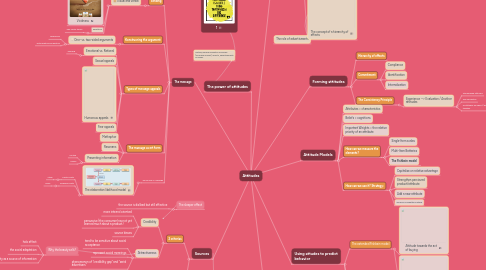
1. Lasting, general evaluation of people (including oneself), objects, advertisements or issues.
2. The power of attitudes
3. Product endorsers
3.1. celebrities
3.2. experts
3.3. typical consumers
3.4. mascots
3.5. virtual avatars
3.6. countries
4. Why the beauty sells?
4.1. halo effect
4.2. the social adaptation
4.3. beauty as a source of information
5. The sleeper effect
5.1. the source is disliked but still effective
6. The message
6.1. Sending
6.1.1. Visual and verbal
6.1.1.1. Vividness
6.1.1.2. Repetition
6.1.1.2.1. Two-factor theory
6.2. Konstrucring the argument
6.2.1. One- vs. two-sided arguments
6.2.1.1. suppoerive
6.2.1.2. both negative and positive
6.3. Types of messege appeals
6.3.1. Emotional vs. Rational
6.3.1.1. bonding
6.3.2. Sexual appeals
6.3.3. Humorous appeals
6.3.4. Fear appeals
6.4. The massage as ert form
6.4.1. Methaphor
6.4.2. Resonans
6.4.3. Presenting information
6.4.3.1. Lecture
6.4.3.2. Drama
6.5. The source vs. messege
6.5.1. The elaboration likelihood model
6.5.1.1. Central route
6.5.1.1.1. Steak
6.5.1.2. Peripheral route
6.5.1.2.1. Sizzle
7. Sources
7.1. 2 criterias
7.1.1. Credibility
7.1.1.1. more internal oriented
7.1.1.2. persuasive (the consumer has not yet learned much about a product)
7.1.1.3. source biases
7.1.2. Attractiveness
7.1.2.1. tend to be sensitive about social acceptance
7.1.2.2. represent social meanings
7.1.2.3. phenomenon of "credibility gap" and "serial advertisers"
7.2. Type of product
7.2.1. High performance risk
7.2.2. High social risk
7.2.3. Low risk
8. 1
9. 1
10. Changing the attitudes though communication
10.1. Persuasion
10.2. Communication model
10.3. Permission marketing
10.4. Uses and gratification theory
10.5. Interactionist
11. The role of advertisments
12. The conent
12.1. Definition
12.1.1. Lasting
12.1.2. General
12.1.3. Functions
12.2. Components
12.3. The concept of a hierarchy of effects
13. Forming attitudes
13.1. Hierarchy of effects
13.2. Commitment
13.2.1. Compliance
13.2.2. Identification
13.2.3. Internalization
13.3. The Consistency Principle
13.3.1. Experience --> Evaluation / Another attitudes
13.3.1.1. Standardized attitudes
13.3.1.2. Self-perception
13.3.1.3. All attitudes are equal // belonging together
14. Attitude Models
14.1. Attributes = characteristics
14.2. Beliefs = cognitions
14.3. Important Weights = the relative priority of an attribute
14.4. How can we measure the elements?
14.4.1. Single-Item scales
14.4.2. Multi-Item Batteries
14.4.3. The Fishbein model
14.5. How can we use it? Strategy:
14.5.1. Capitalize on relative advantage
14.5.2. Strengthen percieved product/attribute
14.5.3. Add a new attribute
14.5.4. Influence competitors ratings
15. Using attudes to predict behavior
15.1. The extended Fishbein model
15.1.1. Attitude towards the act of buying
15.1.2. Theory of reasoned action

